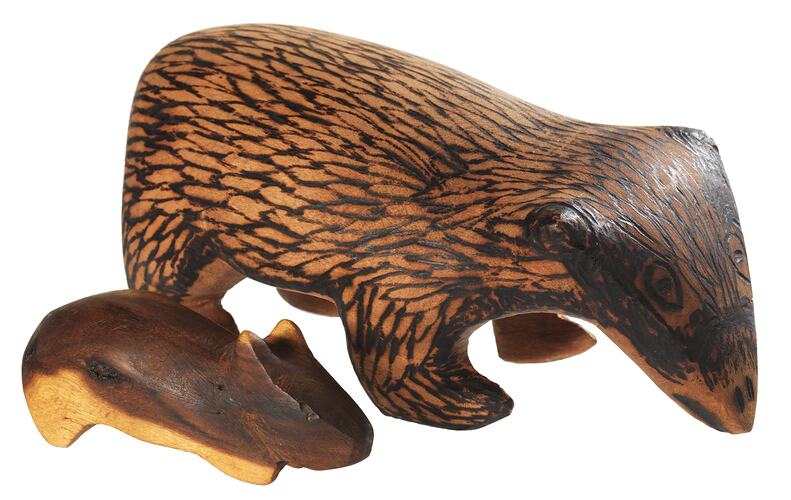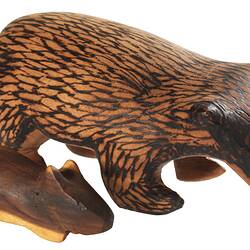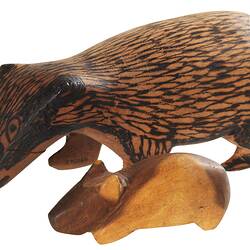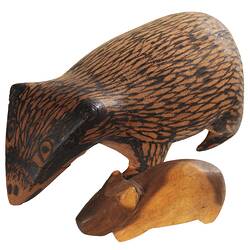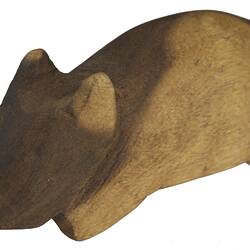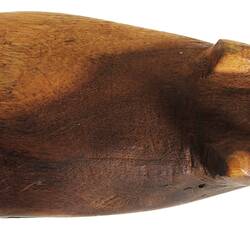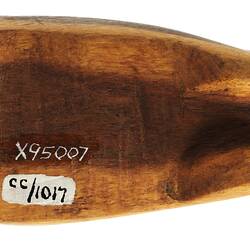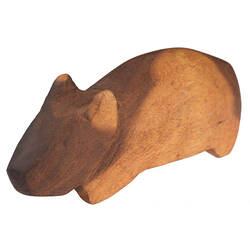Summary
An artist from Yalata carved this baby wadu (wombat). The Yalata people traditionally inhabit the remote western areas of South Australia. They regard themselves as southern Anangu (people from the Central and Western Desert) and speak a dialect of the Pitjantjatjara language.
The wadu joey lives in its mother's pouch and stays with her for about two years before looking after itself. The female wadu's pouch opens backwards, so that when digging a burrow she doesn't cover her young with sand. The wadu has thick, soft fur and strong legs and claws for digging.
A very shy and nocturnal animal, it spends most of the day asleep in a burrow; in the evening and at night this herbivore looks for food, eating grasses, tree roots and soft mosses. To keep itself clean the wadu has a dust bath, lying on its side and scooping sand over itself.
Local Name
Wadu
Physical Description
Carved wooden wombat. Smooth and undecorated and variegated in colour.
Significance
Unfortunately, because historical collection practices did not properly acknowledge Indigenous artists or, in many cases, the diversity and uniqueness of their Country and Nations, the artist who made this beautiful work was not recorded.
It is known that the artist from the Yalata community, a community which identifies as southern Anangu (people from the Central and Western Deserts) and speaks a Pitjantjatjara dialect.
These people originally came from the desert in the north and north-west and were removed from their lands in the late 19th century, largely as a result of pastoral leases. They were again forcibly displaced in the 1950s when nuclear tests were conducted on their ancestral lands without their knowledge or permission with devastating and long-lasting effects on both the people and their Country. The families eventually settled on a mission in coastal South Australia. Today, the Anangu live in small communities and outstations across over 103,000 square kilometres of their traditional lands. In the summer, family groups move north to attend ceremonies.
Most recently, Yalata community artists have told their story in relation to the devastating effects of nuclear testing on their Country and peoples through a sculpture which was presented to the Japanese community at Nagasaki, a community who were also catastrophically affected by atomic bombings. Yalata community leader Russell Bryant commented on the powerful connection and friendship experienced as part of this cultural exchange;
'Japan and Yalata people, Maralinga people, they both got same stories'.
Russell Bryant, 2016.
References
ABC News, Maralinga Nuclear Test Survivors Connect with Japanese Bombing Survivors, 2016, Viewed 23 August 2017.
http://www.abc.net.au/news/2016-04-14/australian-japanese-nuclear-survivors-connect-maralinga-nagasaki/732637
More Information
-
Object/Medium
Animal figure
-
Maker
-
Cultural Groups
-
Locality
-
Date Produced
-
Object Measurements
120 mm (Length), 50 mm (Width), 45 mm (Height)
-
Classification
-
Date Made
-
Maker
-
Clan/Language Group
-
Place Made
-
Indigenous Region
-
Keywords
-
Collection Names
-
Type of item
-
Discipline
-
Category
-
Collecting Areas
